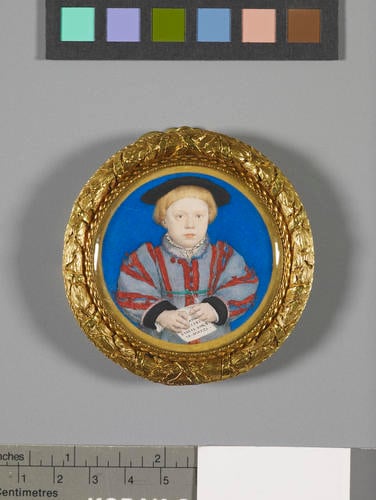-
1 of 253523 objects
Charles Brandon, 3rd Duke of Suffolk (1537/8-1551) Signed and dated 1541
Watercolour on vellum laid on playing card (the ace of clubs) | 5.5 cm (Support diameter) (support, diameter) | RCIN 422295

Hans Holbein the Younger (1497/8-1543)
Charles Brandon, 3rd Duke of Suffolk (1537/8-1551) Signed and dated 1541

Hans Holbein the Younger (1497/8-1543)
Charles Brandon, 3rd Duke of Suffolk (1537/8-1551) Signed and dated 1541


-
Charles Brandon, third Duke of Suffolk, was the younger son of Charles Brandon, first Duke of Suffolk, and his fourth wife, Katherine Willoughby. He succeeded his elder brother Henry Brandon (422294; Royal Collection) as Duke of Suffolk in 1551, but survived him for less than an hour, dying, like his brother, of the sweating sickness. On his death, the Dukedom became extinct.
Charles Brandon is shown holding a paper which is inscribed with the sitter’s age when painted and the date on which the miniature was executed, 10 March 1541. A device often used in Renaissance portraits of adults to indicate learning or gravitas, it recurs elsewhere in Holbein’s work such as in his portrait of Hans of Antwerp (1532; 404443, Royal Collection). In conjunction with the serious and thoughtful gaze of the sitter, it serves here to emphasise his studious, perhaps even precocious, nature. The viewer may even be invited to believe that at the age of three he is presenting us with an inscription that he has written himself. This early promise of intellectual attainment was fulfilled during the following decade and such was the standing of the Suffolk brothers amongst the scholarly community at the time of their deaths in 1551 that a eulogy (Vita et obitus duorum fratrum Suffolciensium) was dedicated to them by Thomas Wilson, their former tutor.
This miniature demonstrates Holbein’s skilful modelling of form by the painstaking application of neat, hatched strokes, particularly in the internal forms of the face where these are laid over an opaque pink carnation ground in tones of grey and red. His success here lies in effectively conveying the delicate childhood beauty and character of the shortlived third Duke on the reduced scale of the miniature through a powerful combination of graphic skill and close observation. This aspect of Holbein’s style was much admired by later miniature painters although few were able to emulate the linearity of his work or the deceptive simplicity of his compositions with such success. Nicholas Hilliard (1547–1619) claimed in his Treatise concerning the Arte of Limning to have imitated Holbein’s style, commending him as ‘the greatest master truly in both those arts after the life that ever was: so cunning in both together, and the neatest, and therewithal a good inventor; ...’ even though his working techniques were at variance with Holbein’s.
This miniature was framed in its present gilt-bronze frame of a leaf and scroll pattern design supplied by J.A. Hatfield of London as part of scheme to re-frame all the historic miniatures instigated by Prince Albert in 1851. Miniatures of this period would originally have been housed in turned ivory or ebony boxes of the type which survives, in an elaborate rose form possibly of German origin, on Holbein’s miniature of Anne of Cleves in the Victoria and Albert Museum, London. Although the miniatures of Henry Brandon and Charles Brandon are listed in Van der Doort’s inventory of the collection of Charles I, no mention is made there of their settings. During the reign of Charles II, they were recorded together in one frame hanging in the King’s Closet at Whitehall Palace.
Text adapted from Northern Renaissance: Dürer to Holbein, 2011Provenance
Sir Henry Fanshawe; by whom presented to Charles I, before 1616; Charles II
-
Creator(s)
-
Medium and techniques
Watercolour on vellum laid on playing card (the ace of clubs)
Measurements
5.5 cm (Support diameter) (support, diameter)
7.2 cm (frame diameter)
5.3 cm (sight diameter)
Category
Object type(s)
Other number(s)